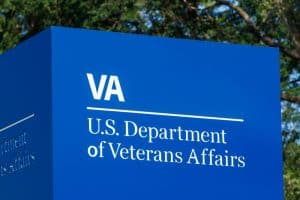
Veterans Affairs AI initiatives aim to deliver proactive healthcare, reduce backlogs, and increase the agency’s effectiveness.
Veterans Affairs is the biggest integrated healthcare system in the country and is hoping to become a medical artificial intelligence leader. The department wants to counteract decades of dissatisfaction with the level of responsiveness in service to the nation’s veterans and hopes that big data and AI-driven decision making will finally help turn the tide.
In a recent Gallup poll, the VA rated fairly poorly in satisfaction as compared to other governmental organizations, something they hope will change as these AI-driven initiatives take place. One of the most significant changes is implementing organization-wide initiatives as opposed to one-off projects of years past.
See also: How AI is Changing the Healthcare Industry
Veterans Affairs creates the National Artificial Intelligence Institution
In 2019, the VA created an entire department dedicated to advancing research and development explicitly pertaining to AI and big data within the VA — The National Artificial Intelligence Institution (NAII). It hopes to push the frontiers of medicine within the VA’s extensive reach, partnering with other departments, external nonprofits and academia, and outside industries.
The goals for the project include a variety of components:
- Sprints designed to innovate aspects of the VA system, such as one designed to make it easier for veterans to connect to clinical trials and experimental treatments. This expands the treatment options for at-risk veterans as well as preventative care.
- Affiliation hubs designed to generalize technological advances for other departments and services. The VA hopes to expand its influence through partnerships and research joint ventures.
- Flagship projects taking on some of the most demanding aspects of VA care as well as new initiatives for research and development. These projects consider a variety of factors and needs as well as direct veteran input.
- Education for new generations of AI scientists, medical practitioners with a tech focus, and other vital components of the VA healthcare system.
Together, this initiative takes a whole-department and beyond approach to AI adoption, hoping to integrate these innovative technologies not as one-off projects but as building blocks to a more efficient, more effective VA healthcare system.
Initiatives within the NAII
The VA began initiatives to address the VA’s traditionally reactive approach to healthcare, rather than proactive. A few of these initiatives aim to reduce things like backlog and increase effectiveness, and more importantly, speedy care.
VSignals and Medallia
One such program is VSignals, designed to use natural language processing and sentiment analysis to identify at-risk individuals based on tone, emotion, vocabulary keywords, and other potential flags.
This program works with both written and oral feedback and responses, allowing the VA to provide assistance potentially within minutes of the flag. It covers a range of issues, including suicide risk, mental health, housing issues, and other areas of support where time is key.
VSignals has taken a longstanding AI marketing use case and expanded its reach to include vital analysis for a population sometimes hesitant to reach out for help.
James A. Haley Veterans Hospital
Two area researchers at the VA facility in Tampa, Florida, are using cutting edge algorithms to better assess and treat cancer. After using new pre-training algorithms, researchers were able to train computers to recognize cancer cells faster and with up to 95% accuracy.
The technology isn’t designed to replace doctors but offers critical diagnostic support in areas with huge caseloads or in rural centers with fewer medical professionals. Researchers are also hoping to generalize the algorithms to make other types of diagnoses, such as spotting signs of brain hemorrhage or detect early signs of a stroke.
Barriers to AI-adoption
Privacy is the VA’s biggest concern at the moment, with so many departments, reporting systems, and sensitive information. The VA is home to the most significant genomic knowledge base in the world and uses veteran records to provide relevant services to at-risk service-members and former members.
Results from some of the AI diagnostic systems are still inconsistent, such as those designed to predict kidney disease. In recent deployment from DeepMind, the software had two false positives for every correct prediction.
Researchers also note that many of the training programs, such as those designed for the kidney screener above, lack the diversity that allows programs to provide clear and efficient results across the board. For the kidney-disease algorithms, a lack of female training examples led to lower performance working with the female veteran population.
Because of these inconsistencies, the algorithms must still be tested in more real-world applications with real patients before deploying at full scale. The expansion of demographics in training as well is a big part of organization-wide adoption.
Explainability is also a clear and present concern. Without transparent AI, researchers and healthcare professionals can’t understand how AI reaches conclusions. This leaves programs open to errors with no resources for fixing them.
However, the agency is confident that the new office, NAII, will allow the VA to refine these approaches and consider further programs for solving current VA issues and backlogs.
The VA in the wake of the pandemic
Of particular concern is the continuation of quality and efficient service, even with COVID disruption in place. The VA launched several initiatives intended to track, diagnose, and predict the disease to reduce its overall effects on the veteran population.
Veterans Affairs has identified critical areas where its participation would help fight the disease. In fact, a project piloted in the summer aims to predict mortality rates using a variety of clinical and non-clinical information.
COVID has strained the already tense situation at many VA hospitals, but AI could help make quick decisions where it counts. Once a veteran receives a positive diagnosis, the next steps are critical. The algorithms analyze a variety of factors to help predict a patient’s risk level.
The algorithm launched in the spring and helps medical professionals look beyond surface indicators to provide a well-rounded prognosis for recovery. The program could help reduce the pressure on hospitals by helping determine the highest risk patients.
Even better, the tool uses explainable AI, a concern that plagues multiple industries, not only Veterans Affairs. Explainable AI allows researchers and healthcare professionals to examine the premise of AI conclusions to improve them over time.
Building a future with AI
The VA appointed its first director for NAII during the summer of 2019, Dr. Gil Alterovitz. The office is a joint initiative between the Center for Strategic Partnerships and the Office of Research and Development.
As Veterans Affairs moves forward with an organization-wide approach, it’s hoping to improve public opinion as well as overall standards of care. Through organizational shifts and investment in research and development, the VA could add another “biggest” to its list — the biggest driver of healthcare AI.



























